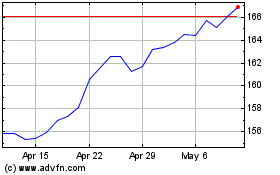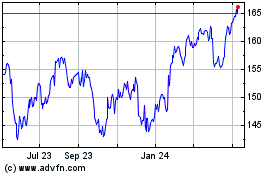Harry's Cuts Into Gillette's Razor Turf -- WSJ
November 11 2016 - 3:02AM
Dow Jones News
Online startup steals in-store sales after it gets shelf space
alongside P&G
By Sharon Terlep and Khadeeja Safdar
When Target Corp. opened its razor aisles to an online upstart,
Gillette paid the price.
In August, Harry's Razor Co., a three-year-old business that
started out selling razors online, put up prominent displays in
Target's nearly 1,800 stores that included four-foot-tall, orange
fixtures in the shape of a razor.
Within weeks, Harry's grabbed a 10% share of the retailer's
cartridge sales and about 50% of razor handle sales, according to
Nielsen data covering the four-week period after the displays
launched in August. Procter & Gamble Co.'s Gillette sales in
Target stores declined in September from a year ago, according to
Target spokesman Joshua Thomas.
Those are outsize numbers given that Harry's had a 2% share of
the overall market for men's razors last year in the U.S.,
according to Euromonitor.
Jefferies analyst Kevin Grundy said Harry's presence in Target
represents a clear challenge to P&G. "Any time you have a
supplier and they have some 75% of market share, it benefits you to
kind of keep that supplier off balance," Mr. Grundy said.
The once-steady $3 billion market for razors and cartridges is
in upheaval. Gillette's overall share of the U.S. market has
dropped from about 70% to 60% since Harry's and its larger online
rival, Dollar Shave Club, came on the scene a few years ago. In
response, P&G started selling subscriptions directly to
consumers with its own online service, the Gillette Shave Club.
P&G declined to discuss Harry's presence in Target. A
P&G spokeswoman noted that Gillette's razor subscription
service gives consumers the option to make the purchase through
Target's website. The company in a statement said it is working to
connect with consumers in "meaningful and relevant ways."
Target executives expressed concern in meetings in the months
after P&G announced its direct-to-consumer offering in 2014,
according to a person familiar with the matter. In January 2015,
Gillette poked fun at the idea of having to go inside a store to
buy razors in social media posts.
"Going to the store to buy blades is so 2014," read the ads,
which ran on Facebook and Twitter.
Retailers like Target have been trying to lure customers who are
increasingly going online to buy household staples. Razor sales
produce slim profits for the chain but are important because they
draw consumers to the store where they buy higher-margin products
like apparel and home items.
In recent months, Target has seen fewer shoppers coming in for
fill-in trips, which are usually made to buy consumables. The
retailer recently reported its first decline in existing store
sales in two years and its stock has fallen about 12% over the past
year. Sales of Target's shaving products, excluding electric
razors, are down 5% for the 52-week period ended Oct. 1 compared
with a year ago, according to Nielsen figures.
"The guest is asking for something different," said John
Butcher, Target's senior vice president of beauty and personal
care. "We think Harry's is filling a niche that wasn't currently
being met."
The idea to sell Harry's blades and cartridges in Target stores
came from Target executives, said Harry's co-Chief Executive Andy
Katz-Mayfield. The two companies started seriously discussing a
partnership around the summer of 2015, he said. Harry's executives
kept the Target talks quiet, giving it the code name "Project
Wildcat."
Harry's viewed Target as a way to expand sales beyond its online
niche, he said. The company has limited offerings at other
retailers and, Mr. Katz-Mayfield said, could continue to increase
its in-store presence. Harry's has a roughly 10% share of the
online razor market, behind Dollar Shave Club's 51% and Gillette
Shave Club's 23%, according to Slice Intelligence, a market
research firm.
Harry's, which collects rafts of data and feedback on its
subscribers, found that many men like buying razors and refills at
stores, but are turned off by the high price of quality razors and
the hassle of the process.
Jefferies' Mr. Grundy attributed the success to the prominent
displays and demand for razors that are seen as a middle ground
between ultra-pricey and cheap. Harry's products on Target's
website range between $5.99 and $15.99, while Gillette products run
from $1.89 to $44.99. But he said Harry's share will likely decline
once the flashy display runs its course.
Write to Sharon Terlep at sharon.terlep@wsj.com and Khadeeja
Safdar at khadeeja.safdar@wsj.com
(END) Dow Jones Newswires
November 11, 2016 02:47 ET (07:47 GMT)
Copyright (c) 2016 Dow Jones & Company, Inc.
Procter and Gamble (NYSE:PG)
Historical Stock Chart
From Mar 2024 to Apr 2024

Procter and Gamble (NYSE:PG)
Historical Stock Chart
From Apr 2023 to Apr 2024
